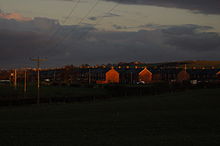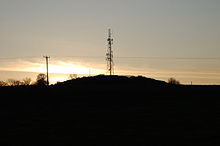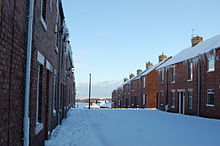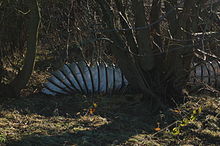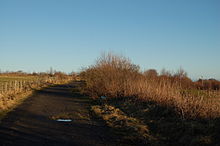- Marley Hill
-
Marley Hill is a former colliery village about six miles to the south west of Gateshead, near the border between Tyne and Wear and County Durham. It has been part of the Metropolitan Borough of Gateshead since 1974. Prior to this it was part of Whickham Urban District. It lies within the Whickham South & Sunniside electoral ward of the Blaydon parliamentary constituency. Neighbouring towns and villages include Burnopfield (2 miles away); Sunniside, Gateshead (about half a mile away); Byermoor (just under a mile away). Marley Hill, Sunniside, Burnopfield and Byermoor all share Whickham's "NE16" postcode prefix, despite Burnopfield sitting just over the border in County Durham.
Contents
Housing
The village consists of several rows of terraced houses, along with a number of detached and semi-detached properties. The oldest existing properties are the former vicarage, the school house, three large detached houses on St. Cuthbert's Road, two stone-built cottages (accessed by a lane leading off to the north-east from St. Cuthbert's Road) and the four rows of houses which form Glamis Terrace, Cuthbert Street and Church Street. The majority of the properties on Cuthbert Street and Church street are two up-two downs, and at one time had outside toilets and tin baths which would have been placed in front of the fire. At some point the houses were modernised and had upstairs bathroom/toilets installed. Some of the outside toilets with their adjoining coal houses remain, but a number have been demolished, or have had the toilet removed and are used as sheds. The houses on Glamis Terrace were intended for colliery officials, and are therefore fewer in number and considerably larger than the others, with gardens at both the front and rear. It is named Glamis because the Bowes-Lyons, the Earls of Strathmore, who were ancestors of the Queen (Glamis Castle was the childhood home of the Queen Mother) owned the colliery and the surrounding land, including the Gibside estate. Church Street and Cuthbert Street are named after St. Cuthbert's Church, which stands at the corner of St. Cuthbert's Road, opposite the former Miner's Welfare Institute (now a community centre housing a nursery and a performing arts school) and the aged miner's cottages.
Church Street is part of the A692 to Consett and forms the main road through the village. The south side of Church Street differs slightly in that the houses all have front gardens, and are slightly larger, with three bedrooms,and the presence of extra chimney pots indicating that they also have additional fireplaces in the kitchen and one of the rear bedrooms. These larger houses also mostly have two narrow windows side by side in the living room and front bedroom, although some have been altered and had larger single windows installed. The bathrooms of these properties occupy a small extension on the back of the house, as opposed to the smaller properties, whose bathrooms were created by partitioning the rear bedroom. Aside from this, the houses are similar in appearance to those on the north side of the road and on Cuthbert Street, which have single windows, and fireplaces in the front rooms only. The only house on these three rows which differs significantly from the others is the first house on the north side of Church street, which consists of two houses which have been knocked through into one property. There is no vehicular access to the front of the properties on Cuthbert Street, with a grassed area occupying the space between the two rows of houses.
The village also had a number of prefab houses, which occupied the large grassed area at the top of Cuthbert Street. These were known as Noble Street and Raby Street. They seem to have been built at some time in the 1950s, and can be seen on the 1960 and 1966 OS maps, but appear to have been demolished by 1970. The section of road which continues past the rear of Cuthbert Street is actually the eastern end of Raby Street. The junction where Noble Street began can be clearly seen at the point where two concrete bollards now stand opposite the top of Cuthbert Street. During very dry weather, the outline of the road becomes clearly visible as a wide strip of lighter coloured grass, running in a westerly direction from the bollards towards Blackamoor Hill. The original concrete surface of Raby Street is still in situ, and runs parallel to Noble Street, beside the hedge. Large numbers of this type of house were built all over the country as a temporary measure to replace housing stock lost during German bombing raids, the vast majority being demolished once replacement housing had been built, but some remain. Examples can be seen locally on Valley Drive in Swalwell, and near the junction of Southfield Road and Washingwell lane on the Watergate Estate in Whickham. The field adjacent to this area is used for cattle grazing, but was at some point used as a rubbish tip, evidence of which can be seen in the form of the old bottles, jars and clay pipes which can sometimes be found poking out of the ground, as well as the presence in the soil of large quantities of ash from coal fires. To increase wartime coal production, the government introduced opencast mining all over the country. One such mine was located in the field immediately to the west the rubbish tip, and appears on the 1951 OS map.
The newer properties in the village are those in the St. Cuthbert's Park estate and Sandygate Mews, which are accessed from St. Cuthbert's road. St. Cuthbert's Park consists of a mixture of detached and semi-detached properties, and was built in the 1990s, as was Sandygate Mews. Sandygate Mews consists of five large detached properties. These, along with the vicarage and The Grange, which stands across St. Cuthbert's Road from the church, are some of the largest houses in the village. The former church hall opposite the entrance to Sandygate Mews has also been converted into a house, and there are another two large properties just to the south of the school. One of these is relatively new, while the other one, Redlands, appears on the 1921 OS map. A building marked "mission room" on the site of the church hall also appears on this map. The building which presently occupies the site does not appear to be old enough to have been built before 1921, but was presumably built to replace an earlier structure of similar dimensions. After falling into disuse, the hall stood empty for a number of years, before finally being bought by a property developer. Although the general outline of the structure has not been altered, its conversion into a home has otherwise rendered it considerably different in appearance.
Sport, leisure, transport and amenities
Sports and leisure facilities consist of a small park with play equipment and basketball hoops situated at the bottom of Cuthbert Street, along with two tennis courts and a bowling green behind the aged miner's cottages, and a football pitch with a small hut containing a changing room to the rear of Cuthbert Street. There was a cricket ground on the south side of the road, just past Redlands, but this disappeared some time in the 1950s. There are also a number of allotments, some beside the main road at the top of Church Street, and more occupying the land between the rear of Glamis Terrace and St. Cuthbert's Park. The only shop in the village is The Crafts House, a gift and craft shop situated at the top of Church Street, opposite the allotments. However, a mobile shop also serves Marley Hill and Byermoor. The Co-op, post office, and other shops at Sunniside are also within easy walking distance. Marley Hill has never had a pub, the only licensed premises in the village being the community centre. The main hall of the community centre serves as the village's polling station during local and general elections. There is a post box on St. Cuthbert's Road, and another outside the shop. There is also a phone box outside the community centre.
The primary school was opened in August 1895 by Sir Charles Palmer, and finally closed over a century later at the beginning of the 2010 Christmas Holidays. At the time of writing the school buildings remain in situ. They are still owned by Gateshead Council and there have been calls to ensure that they are retained for public use. The Sacred Heart R.C. school in the neighbouring village of Byermoor was also under threat of closure, with the intention that the pupils would join those from Marley Hill at other schools in the area, mainly Clover Hill and Washingwell primaries in Whickham, although this decision was subsequently reversed. Prior to closure, two wooden-bodied mine tubs from the colliery stood outside the front of the school for many years. These had gradually fallen into a state of disrepair, and were subsequently removed for restoration. This having been completed, they were unveiled on the 6th of October 2011 by Gateshead's Mayor, Councillor Joe Mitchison, in a new position on the grassed area in front of the aged miner's cottages during a small ceremony attended by the area's three Liberal Democrat councillors, who had secured the funding to have them restored.
The village has excellent public transport links, with Go North East "Diamond" services 43 & 44 connecting it with Newcastle via Whickham and the MetroCentre, and Durham via Stanley. "West Durham Swift" services X70 and X71 from Consett also serve the village, reaching Newcastle via Gateshead. Service 70 replaces these two services on evenings and Sundays. Prior to Go North East's introduction of branded routes in 2004, it was served for many years by services 705-8, X36, 794, 933 and 770. The latter featured on the "100 Years of British Buses" series of stamps issued by Royal Mail in 2001. The only services which survived this change were services 933, which is a twice daily works service between Consett and the Team Valley Trading Estate, and service 794 between Stanley and the government office complex at Longbenton: these run through the village in the morning, with a return journey in the evenings. Although the DSS technically ceased to exist in 2001 (with the site now being jointly occupied by its replacement, the DWP and HMRC), it is still stated as "DSS Longbenton" on the timetable. As of August 2011, this service continues to Balliol Business Park, where HMRC have more offices. There are three bus stops for Newcastle-bound services: one near Longfield Farm, one opposite the allotments, and one at the bottom of Church Street, by the aged miner's cottages. There were four on the opposite side of the road, one outside the church, one opposite the shop, one outside the school and one near the farm. Both stops near the farm are seldom used due to their isolated location, and the stop outside the school became redundant with the closure of the school. The busy nature of the road necessitated a crossing patrol for the children, and a Lollipop Lady was stationed near the shop. This also became unnecessary after the school closed.
Old Marley Hill, collieries, railways and associated industry
Marley Hill Colliery and the adjoining coke works were situated in the area known as Old Marley Hill, further along St. Cuthbert's Road (which is closed to vehicles beyond a large metal gate just past St. Cuthbert's Park), and at one time most of the village, including houses, a shop, a post office and two Chapels (Wesleyan and Primitive Methodist, the latter being situated at the end of one of the rows of colliery houses, reputedly earning it the nickname "Ranter's Row") were centred around the colliery itself. There was also a row of very basic houses which was originally called Fen House Row, after a large house which stood in the field behind them, but came to be known simply as "The Hole" or "The Valley." Heading towards the pit, these were on the right hand side of St. Cuthbert's road, just beyond the gate. The houses backed onto the steep hillside along the pit road, and some of them were flattened by a landslide around the turn of the last century. The rest were demolished in 1920. There were also three terraces nearer the A6076 which runs from Sunniside to Stanley; Bowes Terrace, Gibraltar Row, and Marley Hill Terrace. These were known collectively as Andrew's Houses. Bowes terrace is visible on the 1938 OS map, but appears to have been demolished by 1951. Gibraltar Row and Marley Hill terrace last appear on the 1966 map but some of the houses were certainly still extant as late as 1973, albeit in a derelict condition, as they appear in the background of a photograph taken that year. Bowes Bridge engine shed on the North Eastern Railway's Tanfield Branch was also in this area and the turntable pit and coaling stage for the locomotives are still extant, alongside the Tanfield Railway, whose car park now occupies the site of Gibraltar Row and Marley Hill Terrace. Bowes Terrace occupied the high ground on the opposite side of the Tanfield Branch, overlooking Marley Hill engine shed, (reputed to be the world's oldest working example) which is still in use by the Tanfield Railway for the storage and maintenance of its locomotives. This shed was actually on the Bowes Railway, which crossed the Tanfield Branch on the level beside the signal box and was owned by the National Coal Board after nationalisation in 1947, whereas the Tanfield branch came under the control of British Railways. There are bus stops either side of the road here, which would have originally been used by the occupants of Andrew's Houses. These are now used mainly by visitors to the Tanfield Railway, and are served by West Durham Swift services X30 and X31 from Lanchester.
The majority of the houses in this area were very basic, and were in an extremely poor condition by the time they were demolished. They were of a similar design to the houses in the pit village at the nearby Beamish Museum. The Bowes Railway ran through a cutting at this point, and the Stanley road crossed it on a bridge. After the closure of the line, this bridge was no longer necessary, and the cutting was backfilled, although the western end of it is still visible adjacent to the signal box, forming the headshunt of the shed yard. There was also another colliery in this area; Andrews House Colliery, which was served by a spur from the Bowes Railway, part of which is still in existence. This is the section of track which crosses the entrance to the shed yard and passes behind the shed, beneath the former coal drops, and continues a short distance to the rear of the site.
Coal was also mined from Blackburn Fell Drift, on the other side of the Stanley road, which was served by the Bowes Railway. It had a relatively short life compared to the deep mine, being driven in 1937 and closing in 1979, with the men transferring to Marley Hill. In contrast to those of its neighbours, the surface buildings of this mine (including stables for the pit ponies) survived in a derelict condition for over twenty years, and the partially blocked entrance to the drift itself, (with tub lines emerging from it) was still visible beneath one of them right up until they were finally removed in the early 21st century. Although the main surface structures are gone, a small hut made from from the yellow bricks characteristic of many local colliery buildings stands on the hill overlooking the site of the drift, on the opposite side of Birklands Lane. Its windows and door have been bricked up, and a small chimney-like structure which appears to be some kind of vent projects from the roof at one end. Looking from the point where the drift emerged, (and assuming the drift ran in a relatively straight line) this structure appears to sit directly above the main roadway. It is therefore a possibility that it housed pumps or an emergency access shaft, or both. This structure does not appear on the 1921 OS map, but is visible on the map from 1951. The 1938-1939 map only has partial coverage of the area, and although it is likely it would have been there by 1937, both this building and the drift entrance are in an area not covered by the map (it is possible that because war with Germany was becoming increasingly likely by this point, and the drift was relatively new and would therefore not appear on earlier maps, it may have been deliberately omitted, so that its precise location would not be revealed should a copy of the map somehow fall into the hands of the Luftwaffe). The trackbed of the Bowes Railway on this side of the Stanley road is now a cycle path, and continues from the site of the drift's screens, past Birkheads Cottages and the adjoining Birkheads Secret Gardens and on to Kibblesworth, where the next colliery on the line was situated.
Andrews House Colliery closed in 1920. The coke works closed in 1937, with coke production transferred to Monkton Coke Works near Hebburn. Many of the men employed at the Marley Hill ovens found work in the newly opened Blackburn Fell Drift. In later years, the coal produced at the colliery was removed in diesel-hauled sets of tubs via the Clockburn Drift, which opened in 1952 and connected underground with the Marley Hill workings. This emerged about two miles from the shafts, on the south bank of the River Derwent. Upon exiting the drift, the tubs of coal immediately crossed the river on a bridge just upstream of the Butterfly Bridge at Winlaton Mill. One of the few photographs of the drift entrance and the bridge can be seen here. The coal was then screened and washed, and taken either to Derwenthaugh Staiths at the confluence of the Derwent and the Tyne, or was used at Derwenthaugh Coke Works.
At the end of the 1970s there were very few collieries left in the area, and with the closure of Eden Colliery in 1980, Marley Hill, which had for some time been the last colliery in Gateshead, became one of the only three remaining collieres in the west of the coalfield. Although the seams were relatively thin, and therefore did not lend themselves easily to mechanisation, the high quality coking coal they yielded had ensured the colliery's longevity. However, a number of factors proved to be the colliery's undoing. The stationary engines which had powered the line shafting in workshops and factories had been ousted by the arrival of smaller and more efficient electric motors, and electric pumps had almost completely replaced large beam engines at water works. British Rail's huge fleet of steam locomotives had gone by the end of the 1960's, and by the late 70's even the NCB's locomotive fleet consisted almost entirely of diesels. The decline of the steel industry greatly reduced the demand for coke and the exploitation of the North Sea oil and gas reserves and the resulting changeover of the domestic gas supply virtually eliminated any demand for coal gas. At around the same time, the gradual transition from coal and coke fires to gas central heating for domestic purposes was well under way, further reducing demand for coal. Although power stations still had an enourmous appetite for coal, this could be easily met by the massive undersea mines in the east of the coalfield, as well as the large opencast sites in Northumberland. The writing was on the wall for smaller collieries like Marley Hill.
Closure finally came in 1983, shortly followed by Bearpark in 1984 and Sacriston in 1985. Ten years after the last coals were drawn from Marley Hill, the closure of the coastal collieries (including Wearmouth Colliery in Sunderland) to which a number of Marley Hill miners had transferred after their own pit closed, saw deep mining in the Durham coalfield finally come to an end, leaving Ellington Colliery in Northumberland as the only north-east pit to survive into the new millennium.
Deep mining was (and still is), a dangerous undertaking, and although it was never the scene of a major disaster like that at the nearby Burns Pit, Marley Hill Colliery was no stranger to the accidents which plagued the industry. In total, around thirty-nine miners lost their lives at the colliery during its one hundred and forty-two years of operation. Some of those killed are buried in St. Cuthbert's churchyard. In addition to the various fatalities which occurred underground, one man was killed when a boiler exploded, and the proximity of the various railway lines and sidings to the houses (with the shunting of wagons taking place day and night) yielded tragic results on at least two occasions: firstly in 1888, when a four year old girl called Elizabeth Langdon was knocked down and killed by a locomotive while walking on the branch that served the original beehive coke ovens which gave Coke Row its name, and again fifty-four years later, when a Mr. John Mitchell was struck by a locomotive while walking home from the colliery at the end of a shift. The date of this particular incident (7 Dec. 1942) suggests that he may have been walking in the dark under wartime blackout conditions. If this was the case, and taking into account how remarkably quiet a steam locomotive which is coasting along under its own momentum can be, (they only make the characteristic chuffing sound when steam is applied to the cylinders, as opposed to diesels, whose idling engines make a noise even when they are stationary) it would possibly explain how neither he nor the driver of the locomotive acted in time to prevent the collision.
Although a return to traditional deep mining methods in Marley Hill and the surrounding area is extremely unlikely, substantial reserves of coal remain. However, these reserves remain largely untapped as they would need to be obtained by opencast mining. This has already proven to be controversial, with a planning application to extract 480,000 tonnes of coal and 100,000 tonnes of fireclay on an area of farmland at Skon's Park, just north of Burnopfield coming up against strong local objection, particularly from Derwent Residents Against Mining Application (DRAMA), led by Burnopfield resident Eddie Stringer, who were supported by former miner and Labour MP Dave Anderson, several Liberal Democrat councillors and the National Trust. These objections centred primarily on the potential issues of noise and dust, large numbers of heavy goods vehicles travelling through Marley Hill, Byermoor and Sunniside, as well as the proposed mine's close proximity to the Gibside Estate. The National Trust eventually bought the 150 acres of land in question for £500,000 in order to prevent further mining applications. As of July 2011, another application, to mine coal in an area adjacent to Birkland Lane near Hedley Hall Farm (to the south-east of the site of Blackburn Fell Drift) has been submitted to Gateshead Council's planning department. Although Liberal Democrat councillor Jonathan Wallace immediately voiced concerns, this application has a greater likelihood of being approved than the proposed Skon's Park site, as this area has a much smaller population, does not lie near the Gibside Estate and an opencast mine was operating nearby relatively recently.
After closure, the headgears and other machinery at Marley Hill Colliery were scrapped and the buildings levelled. A hole was knocked into the wall of the square building which enclosed the top of one of the shafts, and the rubble from the rest of the buildings tipped in to backfill it. This process having been completed, the building was demolished and a large concrete cap placed over the mouth of each shaft. There appear to be only two remaining buildings directly associated with the colliery. One of these is what appears to be an airlock above a backfilled access or ventilation shaft from the Clockburn Drift, hidden away in Clockburn Wood near Whickham (although it is possible that this may in fact pre-date the drift and actually be part of Axwell Park Colliery, which was situated roughly a mile to the north-east, and closed in 1954). The other is a curious rendered brick hut of double-walled construction, with heavy steel doors, which stands just to the south of St. Cuthbert's park, in a field behind the school. This is the colliery's former powder magazine, where explosives for use underground were stored. It was presumably constructed sometime in the first couple of years of the 20th century, as the bricks used, which bear the name "Blythe & Sons, Birtley Station" along with the letters ER (Edward VII) and the date 1901, are identical to those used to construct Church Street, Cuthbert Street and Glamis Terrace. It has evidently been specifically designed to direct the force of any explosion upwards, with its isolated location meaning that the resulting debris would not land on the surrounding houses or colliery buildings. It is (for unknown reasons) sometimes referred to locally as "the butterfly chambers." It fell out of use some time before the colliery closed, with one former Marley Hill miner recalling playing in it as a child. A new explosives store was built to replace it, this building being situated near the pit head baths.
The land on which the original village and the pit itself stood (along with the site of the cokeworks and Bowes Bridge MPD) has lain empty since the colliery was demolished, although the foundations of a number of buildings, a few old concrete lamp-posts, some of the tub lines, and the concrete caps covering the backfilled shafts are still clearly visible. The baths are easily identifiable, with drainage channels running down the centre, and post-holes where the shower stalls would have been. The NCB sign which stood at the entrance to the colliery is now on display in the Tanfield Railway's carriage shed. Almost thirty years after closure, nature has largely reclaimed the site, with an abundance of wildlife having taken up residence, and the area is well known locally for the rich pickings to be had when blackberries are in season. However, the entire area remains covered in spoil from the colliery, and there is still a considerable amount of junk, such as steel toe-capped wellingtons, compressed air hoses and ventilation ducting lying around in the undergrowth. Fly tipping has also a been a problem, with a notable incident occurring in October 1998, when a vast heap of tyres which had been dumped in the gill adjacent to the site of the cokeworks was set alight.
High Marley Hill
High Marley Hill stands on the brow of the hill to the west of the village, about halfway between Byermoor and Marley Hill itself. It consists of three cottages beside the road, a large house which is accessed via School House Lane, Longfield Farm, a pallet works which occupies the former High Marley Hill School buildings, and several buildings surrounding a large radio antenna, which sits on top of Blackamoor Hill. There was an anti-aircraft battery near High Marley Hill during World War II, and a drift mine which closed in the 1960s, as did the nearby Byermoor Colliery. The 1951 OS map shows an opencast mine in the field beside the road, near the farm (marked on the map as Longfield House) and there is an embankment which runs parallel to School House Lane, from the site of the drift to the remains of a large retaining wall. This was presumably a loading point on the Bowes Railway, the trackbed of which is still visible, running alongside St. Cuthbert's Road. The presence of a large flat area of waste ground on the opposite side of the road to the wall is a possible indication there were railway sidings here. It is not known whether this loading point also handled the output of the opencast. The 1951 map also shows a terrace called Waggonway Row just beside the retaining wall. The outline of these houses can be seen from the air and is visible on Google Maps. The large house on School House Lane has several outbuildings which appear to have been associated with the drift. This theory would explain the presence of a sign on the wall of the building nearest the road which reads "UK Coal Monitoring Station." School House Lane forms the southern end of St. Cuthbert's Road, and vehicular access beyond the large house is prevented by a large concrete block which has been placed in the centre of the lane.
Categories:- Villages in County Durham
Wikimedia Foundation. 2010.

